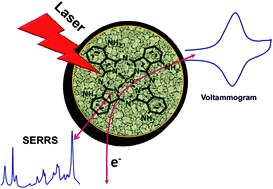Towards improved precision in the quantification of surface-enhanced Raman scattering (SERS) enhancement factors: a renewed approach†
Abstract
This paper demonstrates a renewed procedure for the quantification of surface-enhanced Raman scattering (SERS) enhancement factors with improved precision. The principle of this method relies on deducting the resonance Raman scattering (RRS) contribution from surface-enhanced resonance Raman scattering (SERRS) to end up with the surface enhancement (SERS) effect alone. We employed 1,8,15,22-tetraaminophthalocyanato-cobalt(II) (4α-CoIITAPc), a resonance Raman- and electrochemically redox-active chromophore, as a probe molecule for RRS and SERRS experiments. The number of 4α-CoIITAPc molecules contributing to RRS and SERRS phenomena on plasmon inactive glassy carbon (GC) and plasmon active GC/Au surfaces, respectively, has been precisely estimated by cyclic voltammetry experiments. Furthermore, the SERS substrate enhancement factor (SSEF) quantified by our approach is compared with the traditionally employed methods. We also demonstrate that the present approach of SSEF quantification can be applied for any kind of different SERS substrates by choosing an appropriate laser line and probe molecule.



 Please wait while we load your content...
Please wait while we load your content...